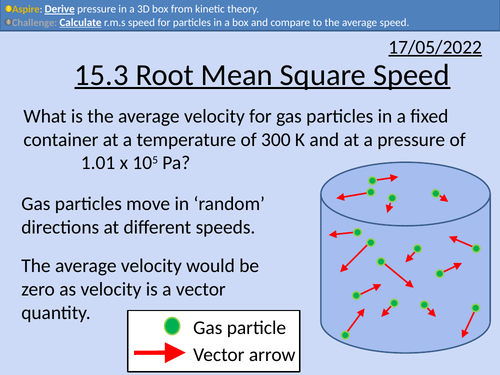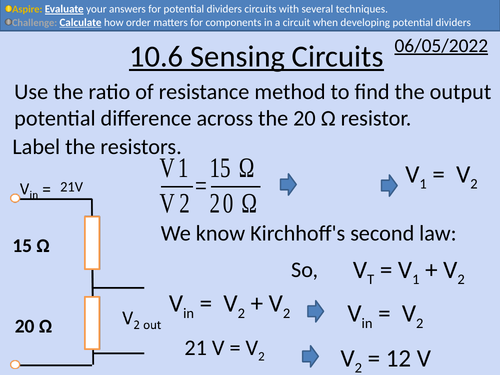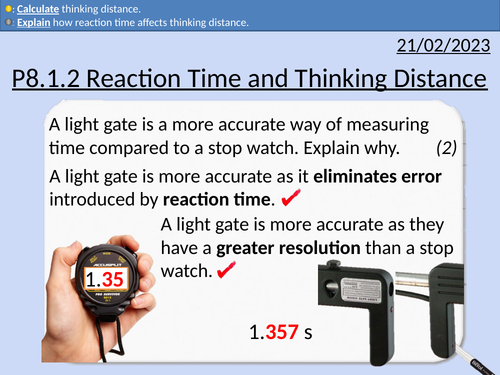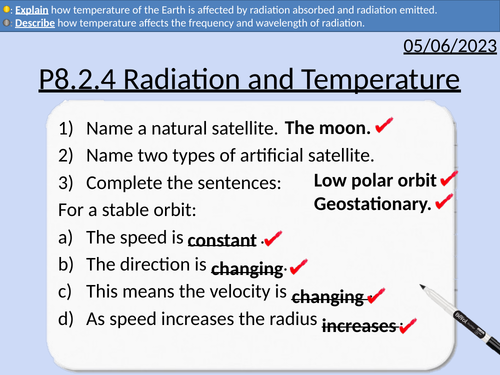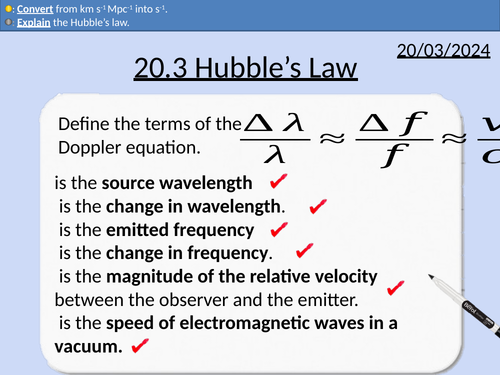497Uploads
168k+Views
72k+Downloads
Physics

OCR AS Physics: Combining Resistors
OCR AS Physics A: Combining Resistors is a part of the Module 4: Electrons, Waves, and Photons. PowerPoint with worked examples and homework.
Rules for adding resistors in series and parallel
Applying adding resistors in series and parallel

OCR AS Physics: Paying for Electricity
OCR AS Physics: Paying for Electricity is a part of the Module 4: Electrons, Waves, and Photons. PowerPoint with worked examples and homework.
Converting time to hours
Using different units for electrical energy
Converting from J to kW hr
Calculating the cost of using different electrical appliances.

OCR AS Physics: Analysing Circuits
OCR AS Physics: Analysing Circuits is a part of the Module 4: Electrons, Waves, and Photons. PowerPoint with worked examples and homework.
Drawing and labeling circuit diagrams
Adding Resistors in Series and Parallel
Ohm’s Law
Kirchhoff’s Laws
The Electrical Power Equation

OCR AS Physics: Reflection & Refraction
OCR AS Physics A: Reflection & Refraction is a part of the Module 4: Electrons, Waves, and Photons. PowerPoint with worked examples and homework.

GCSE Physics: Generators
This lesson presentations covers OCR Gateway Physics 9-1 P4.2.4 Generators.
Uses of generators
AC and DC definitions
Structure of dynamos and alternators
Comparing dynamos and alternators.
Plotting graphs for induced potential difference from dynamos and alternators
Commercial generators, 230 V at 50 Hz.

GCSE Physics: Specific Heat Capacity
This presentation covers OCR Gateway Physics 9-1 P1.2.3
Presentation includes:
Definition of SHC
Real life examples of SHC
SHC equation with example
SHC equation questions with worked solutions
Exam question with solution

GCSE Physics: Electromagnetic Waves
These presentations cover the OCR Gateway Physics 9-1 P5.2.1 Electromagnetic Waves. Includes student activities and full worked answers.
Order of the electromagnetic spectrum
Wavelength and frequency relationship
Application of wave speed equation
Rearranging equation
Producing and detecting radio waves

OCR A level Physics: Specific Latent Heat
OCR A level Physics: Specific Latent Heat is a part of the Module 5: Newtonian World and Astrophysics. The PowerPoint presentation includes worked examples, solutions and a homework.

OCR A level Physics: Root mean square speed
OCR A level Physics: Root mean square speed is a part of the Module 5: Newtonian World and Astrophysics. The PowerPoint presentation includes worked examples, solutions and a homework.

GCSE Physics: Kinetic energy and Work done
This presentation covers OCR Gateway Physics 9-1 P7.1.1b Kinetic energy and Work done.
PowerPoint includes student activities with fully worked answers included.
Work done and kinetic energy equations
Rearranging equations
Mechanical energy transfer and work done
Kinetic store transfered mechanically to a thermal store through brakes.
Bundle

GCSE OCR Physics: P7.1 Energy and Forces
All resources for P7.1 Work Done GCSE OCR Physics Gateway 9-1. Triple and combined (Higher and Foundation) is covered in this material.
Energy Stores and Energy Transfers
Work Done and Kinetic Energy
Work Done, Kinetic Energy and Thermal Energy
Work Done and Spring Energy
Gravitational Energy
Kinetic Energy
Kinetic and Gravitational Energy
Gravitational and Spring Energy
Gravitational Force and Energy

GCSE Physics: Gravitational and Elastic Energy
This presentation covers OCR Gateway Physics 9-1 P7.1.7 Gravitational and Elastic Energy
Energy transfers with links to sport and PE.
Employer-mentor links with physics and sports
Exam Style Question with worked solutions
Rearranging equations
Practice Questions with worked solutions

GCSE Physics: Work Done, Kinetic and Thermal Energy
This presentation covers OCR Gateway Physics 9-1 P7.1.3 Work Done, Kinetic and Thermal Energy
Comes complete with students activities and fully worked solutions.
Energy transfers to thermal store.
Thermal energy, equation, and specific heat capacity.
Work done equation and kinetic energy equation.
Rearranging equations.
Applying equations.
Student questions with fully worked solutions.

OCR AS Physics: Sensing Circuits
OCR AS Physics: Analysing Circuits is a part of the Module 4: Electrons, Waves, and Photons. PowerPoint with worked examples and homework.
Kirchhoff’s Laws for potential difference
Thermistors and LDRs in sensing circuits
Ratio of resistances and ratio of potential differences

GCSE Physics: Reaction Time and Thinking Distance
This presentation covers OCR Gateway Physics 9-1 P8.1.2 Reaction Time and Thinking Distance. All presentations come with student activities and worked solutions.
Reaction time definition
Factors that increase reaction time
Simple reaction time experiment
Thinking distance
Rearranging equations
Speed equation
(Final velocity)2 – (Initial velocity)2 = 2 x Acceleration x Distance
v2 – u2 = 2 a s

GCSE Physics: Radiation and the body
This presentation covers OCR Gateway Physics 9-1 P6.2.1 Radiation and the body
This PowerPoint is a whole lessons included with student activities and animated answers.
Background radiation definition
Sources of background radiation
Contamination and irradiation
Medical examples of irradiation - X-rays, sterilisation, gamma knife
Medical examples of contamination - Tracers
Half-life and penetration power for radioactive tracers.

GCSE Physics: Radiation and Temperature
This presentation covers OCR Gateway Physics 9-1 P8.3.4 Radiation and Temperature
This PowerPoint is a whole lessons included with student activities and animated answers.
All objects emit electromagnetic radiation
Describe how changing temperature changes frequency, wavelength, and intensity of the radiation produced.
Explain why objects change temperature by absorbing and emitting radiation.
Explain why the temperature of the Earth changes due to greenhouse gases in the atmosphere.
Bundle

GCSE OCR Physics: P8 Global Challenges
All resources for P8 Global Challenges GCSE OCR Physics Gateway 9-1. Triple and combined (Higher and Foundation) is covered in this material.
Average speeds of walking, running, cycling, cars, trains, wind, sound, and light.
The speed equation
The acceleration equation
Explaining average speed camera
Explaining instantaneous speed camera
Estimating everyday accelerations
Calculating speed from rotation speed and circumference of wheels
Converting from miles per hour to meters per second
Reaction time definition
Factors that increase reaction time
Simple reaction time experiment
Thinking distance
Rearranging equations
Speed equation
(Final velocity)2 – (Initial velocity)2 = 2 x Acceleration x Distance
v2 – u2 = 2 a s
Factors affecting braking distance
Total stopping distances
Calculating area of a velocity-time graph for displacement (distance traveled).
Rearranging equations
MOT testing
Large accelerations produce large forces.
Values of g that cause severe injury or death
Road Safety
Newton’s First Law and seat belts
Crumple zones
Force = Mass x Acceleration
Acceleration = Change in velocity /Time taken
Estimating speed, accelerations and forces involved in large accelerations for everyday road transport.
Types of different energy sources
Renewable and non-renewable definitions
Different uses of energy sources - transport, heating, and generating electricity
Advantages and disadvantages of different energy sources
Fossil fuels – oil, coal, and natural gas.
Nuclear fuel – Uranium
Biofuels – wood, biodiesel, and biogas.
The sun - solar (PV) panels and solar heating panels
Tides
Waves
Hydroelectricity
Wind
Geothermal
How use of energy resources have changed over time. (Biofuels, Fossil Fuels, Nuclear, Renewable).
How energy use has increased (increase population and development of technology)
Explain patterns and trends in the use of energy resources.
Fossil fuels are finite and will run out at current consumption levels.
Structure of the National Grid
Step-up and Step-down transformers
How transformers increase the efficiency of the National Grid
Number of turns and potential difference
Current and potential difference in primary and secondary coils
Domestic Electrical Supply being 230 V, AC at 50 Hz.
Direct potential difference and alternating potential difference.
Reasons for insulation on wires.
Potential Difference between different conductors.
Function of the earth conductor.
Double insulation and no earth wire.
Reasons the live wire is dangerous.
Reasons why live to earth is dangerous.
Key facts about the Big-Bang model
Cosmic Microwave Background (CMB, CMBR)
Doppler Red shift of light from stars in galaxies
Hubble’s evidence of absorption spectra being red shifted
Structure of the solar system
Nuclear Fusion
Evolution of large stars
Evolution of Sun like stars
Gravitational force and force from nuclear fusion
Natural Satellites
Geostationary Satellites
Low Polar Orbit Satellites
Speed is constant and velocity is changing in stable orbits.
Changing speed and radius
Gravitational force, acceleration, and speed.
Plotting data and describing relationships
All objects emit electromagnetic radiation
Describe how changing temperature changes frequency, wavelength, and intensity of the radiation produced.
Explain why objects change temperature by absorbing and emitting radiation.
Explain why the temperature of the Earth changes due to greenhouse gases in the atmosphere.
S and P waves
Structure of the Earth
Reflection, absorption, and refraction of waves
Sonar to map the ocean floor

GCSE Physics: EM waves - Uses and Dangers
This presentation cover the OCR Gateway Physics 9-1 P5.2.2 Uses and Dangers of EM radiation. PowerPoint includes student activities with full worked answers.
Recall that light is an electromagnetic wave
Give examples of some practical uses of electromagnetic waves in the radio, micro-wave, infra-red, visible, ultraviolet, X-ray and gamma-ray regions
Describe how ultra-violet waves, X-rays and gamma rays can have hazardous effects, notably on human bodily tissues.
Explain that electromagnetic waves transfer energy from source to absorber to include examples from a range of electromagnetic waves
Precautions for ultra-violet waves, X-rays and gamma rays

OCR A level Physics: Hubble’s Law
OCR A level Physics: 20.3 Hubble’s Law
Module 5 Newtonian World and Astrophysics
This PowerPoint is a whole lesson included with student activities, animated answers, homework questions with answers provided.
This lesson covers:
The Cosmological Principle
Hubble’s Observations
Hubble’s Law
Hubble’s constant and the gradient of a graph
Converting between km s-1 Mpc-1 into s-1
The expanding Universe model.









